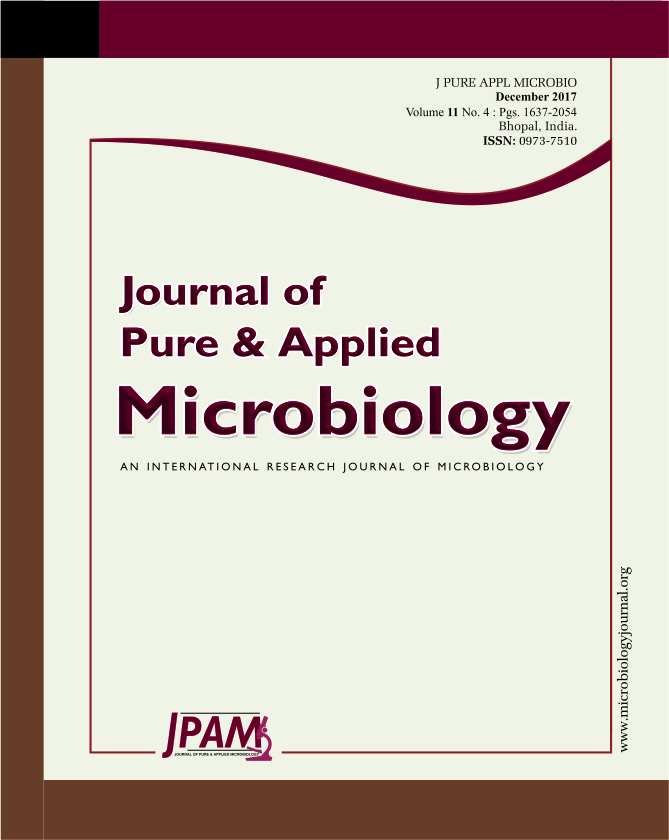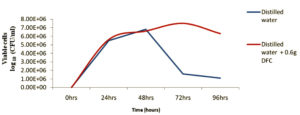ISSN: 0973-7510
E-ISSN: 2581-690X
Date seeds/ kernels are currently used in the feeding of animals such as cattle, sheep, and camel, and in the poultry and fish industries as well. Due to the presence of a large quantity of total dietary fibre they are considered to have potential health benefits for human as prebiotics. The present study was aimed to investigate the effects of the date palm (Phoenix dactylifera L.) seed products in the form of (i) the finely ground date seeds powder (FGDSP) and (ii) the aqueous extract of date seed powder (AEDSP) on the growth of the lactic acid bacteria (LAB) Lactobacillus paracasei ssp paracasei as probiotics. Subsequently, to investigate the prebiotic properties of the date palm (Phoenix dactylifera L.) seed product i.e dietary fibre concentrate (DFC) in stimulating the growth of the probiotic. The total numbers of bacterial populations at 0, 24, 48, 72 and 96 h of fermentation were checked for each sample during the fermentation period. The data obtained clearly demonstrated that both the form of test date palm (Phoenix dactylifera L.) viz. FGDSP and AEDSP could be used as a carbon source for bacterial fermentations. The DFC presented the potential to be applied as a novel source of prebiotics, by increasing the population of Lactobacillus paracasei ssp paracasei as probiotics in addition to decreasing the pH values. This research proposed that date seeds could potentially be utilized as a starting material to manufacture functional food ingredients especially as they are a common waste product, especially in Middle Eastern countries. Hence, further investigations should be carried out to identify active biological molecules in date seeds and their potential application in encouraging the growth of probiotics and other health benefits.
Dietary fibre, Lactobacillus paracasei, Phoenix dactylifera, probiotic.
Probiotics are defined as “live microorganisms which when administered in adequate amounts confer a health benefit on the host” (FAO/WHO 2002). The most common probiotics are lactic acid bacteria (LAB) especially Lactobacilli and Bifidobacteria spp which are usually used in fermented products like dairy products. Prebiotics are defined as “nondigestible food ingredients that beneficially affect the host by selectively stimulating the growth and/or activity of one or a limited number of health promoting bacteria in the colon, and thus improving the host’s health” (1). Food products containing probiotics and prebiotics in which prebiotics selectively favours probiotics are termed as synbiotics. All of these have been investigated for their properties by food scientists to support their claim of inclusion in functional food (1) with relation to health promotion or disease prevention. Consequently, one of the current challenges in nutrition sciences is improving gut health, using the concept of functional foods as a health promoting tool. According to Gibson et al. (2) and Wang, (3) the scientific criteria that must be met for functional food ingredients to be recognized and classified as prebiotics are that they (i) are able to escape digestion in the upper GIT and not absorbed (ii) are fermented by the intestinal microflora (iii) are a selective substrate that changes colonic bacteria composition by stimulating the growth of beneficial colon bacteria such as Lactobacilli or Bifidobacteria spp, and inhibiting the growth of pathogenic bacteria like Enterobacteriaceae and Clostridium spp. ( (iii) positively affects the host health by producing short chain fatty acid and antimicrobial compounds such as acids, bacteriocins and H2O2, in addition to adhesion sites and antagonism on growth substrates (iv) can withstand food processing treatments.
The term “dietary fibre” is applied to all non-digestible polysaccharides. Dietary fibre is a common definition that includes resistant starch; non starch-polysaccharides (NSP) such as cellulose, hemicelluloses, pectin and gums; gluco-oligosaccharides; lignin and seaweed polysaccharides and nondigestible oligosaccharides such as fructo-oligosaccharides (FOS), galacto-oligosaccharides (GOS), lactulose and inulin. In addition, some sugars are also considered in this category, such as raffinose, lactose, and stachyose, and sugar alcohols, e.g., sorbitol and xylitol. There are many food additives known to be non-digestible carbohydrates in the small intestinal tract but that are digested in the colon by colonic microbiota (1). Although all dietary fibres are non-digestible polysaccharides but not all dietary fibres are prebiotics, and not all non-digestible oligosaccharides are prebiotic. However, any dietary ingredients such as non-digestible carbohydrates, lipids or proteins that can reach the colon could potentially be considered as prebiotics. The best known prebiotics are currently the non-digestible oligosaccharides such as fructo-oligosaccharides (FOS), inulin, galacto-oligosaccharides (GOS) and lactulose, all of which are commercially available (4).
Nowadays, there is increasing interest in the investigation, identification and development of novel prebiotic compounds, to support the claim of using functional foods as an alternative approach for promoting health and reducing the risk of diseases (4, 5, 6, 7, 8). In this perspectives, the fruit of the date palm (date), a popular food product in the Middle East, has been claimed for hundreds of years for its nutritional and health benefits in human and animal uses. have been claimed for.
The Date Palm tree (Phoenix dactylifera L) is one of the oldest cultivated plants and has been used by man for over 6000 years (9). It is a monocotyledonous woody perennial plant belonging to the Arecaceae family, which contains over 200 genera and at least 3000 species (10). The date is composed of a fleshy pericarp and a seed. The seed constitutes on average between 13% and 15% of the date fruit weight (11). Date seeds are also called kernels, pits, stones or pips. They are considered as waste material of the several date processing plants that produce date powders, date juice, date confectionery, date syrup, pitted dates, date chocolate and coated dates. Worldwide production of dates was around 6.9 million tonnes in 2004, from which about 863 thousand tonnes of date seeds were disposed of as a waste product (12).
The chemical constituents of date kernels have been studied by several researchers (12; 13; 14; 15; 16; 17; 18; 19). Based on the nutritional profiles of the fat, mineral, protein and carbohydrate content of the date kernels, it has been suggested that date kernels could be regarded as an excellent source of functional foods with interesting technological functionalities that could also be used as an important source of dietary fibre.
A good source of functional food ingredients, particularly prebiotics, is one that contains a large quantity of carbohydrates, especially non-digestible carbohydrates like dietary fibre. . Dietary fibre concentrates obtained from date kernels could potentially be an inexpensive source of natural dietary fibre and probably a functional food ingredient (12). Noticeably, very limited use of date kernels is currently made despite the many thousands of tons of date kernels that are discarded each year. Thus, exploitation of such waste is very important in date cultivation and to raise income to this sector, especially if that product has a potential use as functional food ingredient in countries where the date palm is grown, such as Middle Eastern countries including Kingdom of Saudi Arabia. Therefore, date kernels have been studied for their potential use in functional foods. In this regard, the date palm kernels being an inexpensive rich source of dietary fiber could be exploited as prebiotics and we attempted to investigate its potential to be claimed as functional food. The objectives in this study were therefore firstly, to investigate the effects of the date palm (Phoenix dactylifera L.) seed products in two forms (i) finely ground date seeds powders (FGDSP) and (ii) the aqueous extract of date seed powder (AEDSP) on the growth of probiotic lactic acid bacteria (LAB) such as Lactobacillus paracasei ssp paracasei. Furthermore, an investigation was made into the prebiotic properties of dietary fibre concentrate (DFC) from the date seeds in stimulating the growth of probiotics.
Preparation of date kernels and their products
Dates (Phoenix dactylifera) were obtained from a local date market in Makkah, Saudi Arabia and kernels were separated from the date flesh by hand-pitting under hygienic conditions. The kernels were soaked in distilled water, washed to remove any adhering date flesh, and then dried at 50°C for two days before being finely ground to 1.0mm in a heavy-duty grinder (Buhler-Miag laboratory disc mill; model DLFU). The kernel powder was sieved in a laboratory test sieve to remove the husk and the larger size powder (1000-700 µm) was collected and kept refrigerated at 5°C until needed to prepare the kernel products using the methods as described by Al-Farsi and Lee (12) with little modifications. Three different products were obtained from these date kernels and subsequently used in this study. The first product was the ground raw powder which was obtained after milling as a finely ground date seed powder (FGDSP). This product was dissolved in distilled water to extract the second and the third products. Briefly, 10 g FGDSP was added to 600 ml distilled water and the solution was placed on a hot plate at 45 °C, at 120 rpm for 3 h. The aqueous extract was separated from the solid slurry by centrifugation at 1000 rpm for 20 min before being filtered through Whatman No. 4 filter paper. The aqueous supernatant that was collected contains the soluble carbohydrate and is the second product and referred to as the “aqueous extract of date seed powder” (AEDSP). The slurry that remains after collecting the AEDSP is the third product and comprises the dietary fibre concentrate (DFC).
Bacterial strains used
The probiotic strain Lactobacillus paracasei ssp paracasei was isolated from Actimel drinking yoghurt obtained locally and reference strains Lactobacillus casei (ATCC 334) and Eshcherichia coli EMG 14 (ATCC 23737) were used as control for various biochemical tests and obtained from American Type Culture Collection. The test strains were cultivated and maintained by sub culturing on MRS broth for LAB and Nutrient broth for E. coli EMG 14 with 30% (v/v) glycerol at -70°C.
The isolation and identification of the probiotic culture from yoghurt were carried out as a modifications of the methods described by (20, 21). Briefly, 1ml of yoghurt was homogenized with 9ml of 0.1% (w/v) sterile Maximum Recovery Diluent (MRD; formulated by adding 1 g peptone to 8.5 g sodium chloride), to obtain a 10-1 dilution. A 0.1 ml of the 10-1 sample were then surface plated in duplicate onto MRS agar and aerobically incubated at 28°C for 48h. Furthermore, 0.1 ml of appropriately diluted samples of reference strains was pour-plated in duplicate on MRS agar and treated the same way as the probiotic sample during its incubation. Inoculated plates were covered with a layer of the same medium to create microaerophilic condition. After incubation, five colonies for each sample were selected from MRS plates and subjected to morphological examination, Gram staining and biochemical tests like oxidase and catalase. Further biochemical test was performed using the API 50 CHL test strip (bioMerieux). An API 50 CHL test was carried to determine their sugar fermentation patterns. The positive and negative fermentation results were reported as described in the manufacturer’s handbook and the species identification made by a computer program which was used to analyzed the results, as recommended by the manufacturer (bioMerieux).
Fermentation protocol
Prebiotic – supplemented growth media
The fermentation media used in this study for the first and second fermentation assays were prepared by modifying MRS-Oxoid selective media for LAB. In the first fermentation assay, MRS with no additional carbon source was used (MRS-C medium as prepared laboratory contains g/L): Peptone,10g; Lab-Lemco powder 8.0; Yeast Extract, 4.0; Sorbitan mono-oleate,1ml; Dipotassium hydrogen Phosphate,2.0; Sodium acetate,5.0; Triammonium citrate,2.0; Magnesium Sulfate 7H2O; 0.2; Magnesium Sulfate 4H2O,0.05; pH 6.2 ± 0.2. It was prepared by removing the glucose substrate from the MRS-Oxoid and adding the remaining ingredients listed on the MRS-Oxoid. In the second fermentation assay, MRS was prepared without peptone, glucose, yeast extract and Lab- Lemco powder (MRS-Min medium used in second fermentation assay contains g/L): Sorbitan mono-oleate;1ml; Dipotassium hydrogen Phosphate,2.0; Sodium Acetate,5.0; Triammonium citrate,2.0; Magnesium Sulfate 7H2O; 0.2 ; Magnesium Sulfate 4H2O; 0.05; pH 6.2 ± 0.2). These media were used in this study with the addition of the three different date seed products i.e. FGDSP, AEDSP and DFC. The fermentation medium used for the third fermentation assay was prepared by using distilled water supplemented by each of the three different date seeds products (Table 1).
Table (1):
Different concentrations of tested FGDSP,AEDSP and DFC product (fermentation media), using isolated same probiotic strain and growth conditions.
Growth medium V) /30 ml medium) FGDSP First fermentation |
Growth medium V) /30 ml medium) (AEDSP)
Second fermentation |
Growth medium V) /30 ml medium) (FGDSP, AEDSP and DFC) Third fermentation |
|---|---|---|
30 ml MRS-Ca |
30 ml Distilled water |
30 ml Distilled water |
30 ml MRS-C + 0.06g FGDSPb |
30 ml Distilled water + 0.6ml AEDSPa |
30 ml Distilled water + 0.6ml AEDSPa |
30 ml MRS-C +0.15g FGDSP |
30 ml MRS-Oxoid |
30 ml Distilled water + 0.6g FGDSPb |
30 ml MRS-C + 0.6g FGDSP |
30 ml MRS-Oxoid + 0.6ml AEDSP |
30 ml MRS-Oxoid + 0.6ml AEDSP |
30 ml MRS-Oxoidc |
30 ml MRS-Min b |
30 ml MRS-Min b |
30 ml distilled water |
30 ml MRS-Min + 0.6ml AEDSP |
30 ml MRS-Min + 0.6ml AEDSP |
MRS-C without glucose substrate; b : FGDSP: Finely ground date seeds powders. c commercially available preparation containing glucose as the carbon source |
a: AEDSP: aqueous extract of date seed powder; b MRS-Min : free from Carbon and Nitrogen sources. |
a DFC: Dietary fibres concentrate, bFGDSP Finely ground date seeds powders; cAEDSP: aqueous extract of date seed powder. |
Probiotoc strain: L. paracasei;
Growth condition (incubated aerobically with shaking at 28°C, for 96h).
Fermentation assays
The three fermentation assays were carried out following the same procedure and under the same conditions with the different tested substrates (FGDSP, AEDSP and DFC). All these different media were prepared in blue–jacketed flasks (30 ml). The flasks were filled with 30 ml growth medium (MRS-C, MRS-Min or distilled water + test substrate) and then, the media was sterilized by autoclaving (121°C, 15 min). To start the fermentation assays, each flask was inoculated with 100 µl of probiotic Lactobacillus (L. paracasei ssp paracasei. The inoculum culture was prepared by inoculating MRS medium and incubating it overnight. 1 ml was taken from that culture and used to inoculate 10ml of fresh MRS- Oxoid medium. The culture was grown for 4-6 h before running the experiment. All the fermentation assays in this study were carried out under aerobic environment conditions at 28°C in a shaking incubator (170 rpm). The fermentation was run in triplicate for each sample.
First fermentation assay to determine probiotic’s ability to utilize finely ground date seed powder (FGDSP)
The first fermentation assay was conducted by using the FGDSP in the flasks. It was carried out on six different samples, four samples that contained different concentrations of FGDSP in synthetic MRS (MRS-C). Two control flasks were used, one with distilled water and another one with fully supplemented MRS (commercially available from Oxoid, and described as MRS- Oxoid).
Second fermentation assay to determine probiotic’s ability to utilise the aqueous extract of date seed powder (AEDSP)
The second fermentation assay was conducted by using the AEDSP in the flasks. It was carried out on six different samples; distilled water, distilled water + 0.6 ml AEDSP, MRS-Oxoid, MRS-Oxoid + 0.6 ml AEDSP, MRS-Min and MRS-Min + 0.6 ml AEDSP. All these samples in this assay contained the same amount of AEDSP, using the amount that resulted in optimal growth in the first fermentation assay. Three control flasks were also used, distilled water, MRS-Oxoid and MRS-C.
Third fermentation assay to determine probiotic ability to utilise the three date seed products (FGDSP, AEDSP and dietary fibre concentrate (DFC))
The third fermentation assay was conducted using the dietary fibre concentrate (DFC), in addition to another two date seed products, the finely ground date seed powder (FGDSP), aqueous extract of date seed powder (AEDSP) in the flasks. The three samples, each was containing 30 ml distilled water, different date seeds substrate (DFC, FGDSP or AEDSP), at the same quantity was identified from the first fermentation assay. One control flask containing 30 ml distilled water was also used. For each test substrate, the total viable count was carried out over 0, 24, 48, 72 and 96h respectively. The total viable count was carried out as described previously in section with the difference that the initial and final pH was checked and recorded for each tested sample after 0 and 96h fermentation
Isolation, identification and characterization of selected probiotic strains isolated from yoghurt
A total of 10 isolates were counted and isolated from Actimel drinking yoghurt. These colonies were representative of all the colonies and displayed the general features of LAB. They were all Gram positive, short rods, non-spore forming, catalase negative and oxidase negative. Isolated probiotic strains grew in MRS media and reduced the pH of the medium from 6.2 to 3.9. For these 10 isolates, further identification was carried out by using the API 50 CHL test, which identified each of the samples as Lactobacillus casei ssp casei. The total viable count of the yoghurt was 1.21×107 CFU/ ml. The API 50 CHL characterization was also conducted on the LAB laboratory stock culture and the API 50 CHL test confirmed the strain as being Lactobacillus casei (Table 2).
Table (2):
Characterization and identification of selected LAB.
Sample |
Microscopic morphology |
Viable count |
Catalase |
Oxidase |
Identification by the API 50 CHL test |
|---|---|---|---|---|---|
Lb. casei (lab Stock culture) Smooth |
G +ve short rods. Circular, convex and white colonies, different sizes, surface and entire edge. non-motile, non-spore forming |
– |
-ve |
-ve |
Lb. casei |
Actimela |
G +ve short rods. Non-motile, non-spore forming small colonies |
1.21×107 |
-ve |
-ve |
L. paracasei ssp paracasei b |
a Drinking yoghurt. b “Lactobacillus casei ssp casei identified as Lactobacillus paracasei ssp paracasei with API 50 CH”.
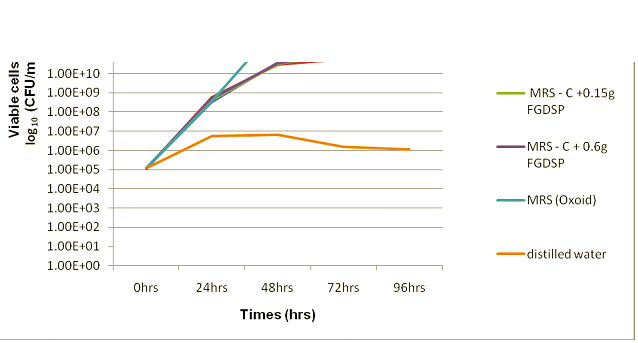
Figure 1.Enumeration of probiotic using different amounts of finely ground date seed powder (FGDSP): The number of probiotic colony forming units (CFU/ml) after 0, 24, 48, 72 and 96h incubation to determine the ability of the probiotic to utilise the finely ground date seed powder (FGDSP); MRS-C + 0.6g FGDSP, MRS-C+0.15g FGDSP and MRS-C + 0.06g FGDSP.
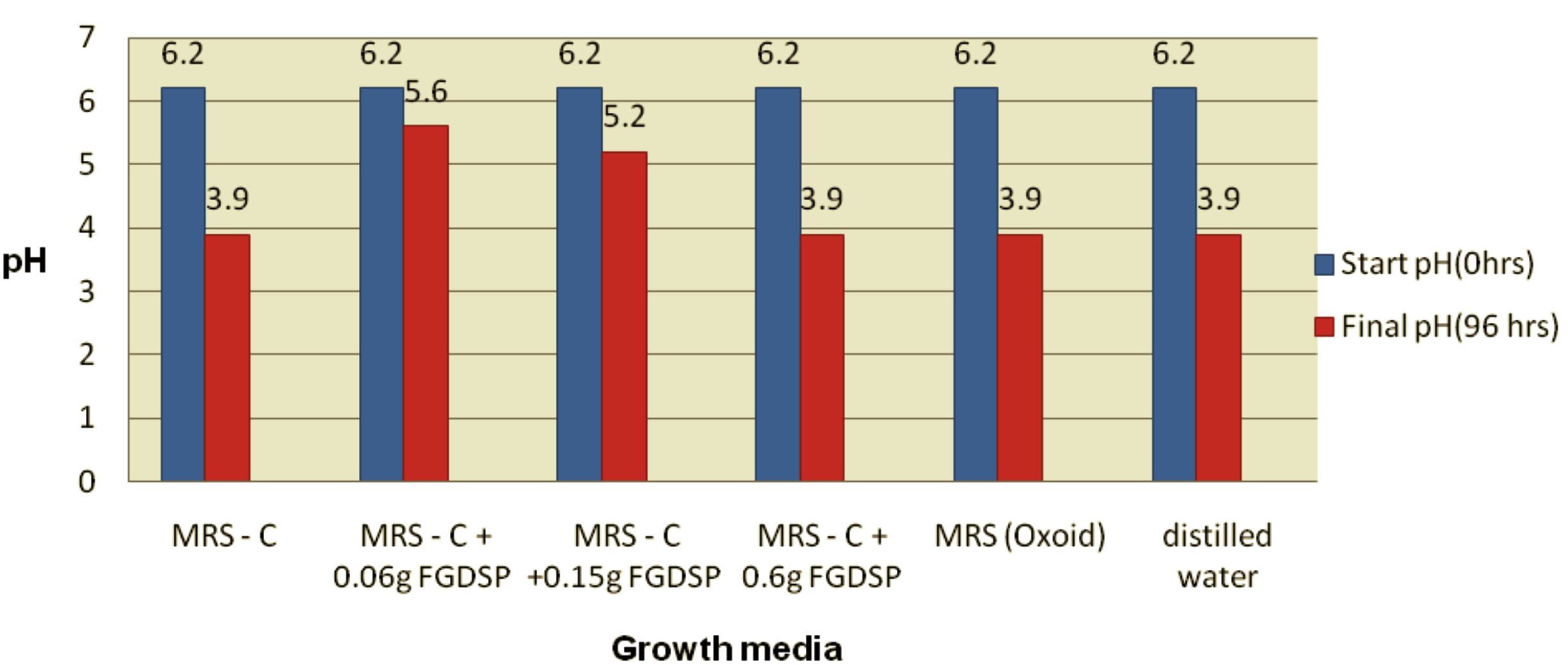
Figure 2.Changes in pH values of FGDSP cultures after 96h incubation in the presence of the substrates as indicated. The starting pH is shown in blue and the final pH in
Viable count of probiotics using different amounts of finely ground date seed powder (FGDSP) as carbon source (First fermentation assay)
The ability of the probiotic micro-organisms to utilise the finely ground date seed as a carbon source was determined by counting the colony forming units during the fermentation period (sampling after 0, 24, 48, 72, and 96 hours incubation). The results shown in table 3 indicate that MRS-C broth containing different concentrations of FGDSP (06, 0.15 and 0.6 g/30 ml) all support the growth of the probiotic culture. In each case, the total cell number of probiotic increased after 24, 48 and 72hr in contrast with the negative control (distilled water) in which the probiotic cell number increased only slightly. After 48 h incubation the distilled water failed to support further growth.
Table (3):
First fermentation assay: Enumeration (CFU /ml) of probiotic using different amounts of finely ground date seed powder (FGDSP) as substrate.
Samples |
0h |
24h |
48h |
72h |
96h |
|---|---|---|---|---|---|
MRS-C |
1× 105 |
3× 108 |
4× 1010 |
8× 1010 |
2× 1013 |
MRS-C + 0.06g FGDSP |
1× 105 |
6× 108 |
3× 1010 |
6× 1010 |
3× 1013 |
MRS-C +0.15g FGDSP |
1× 105 |
4× 108 |
3× 1010 |
1× 1011 |
2× 1014 |
MRS-C + 0.6g FGDSP |
1× 105 |
5× 108 |
4× 1010 |
1× 1011 |
2× 1014 |
MRS-Oxoid |
1× 105 |
4× 108 |
3× 1012 |
2× 1011 |
3× 1014 |
Distilled water |
1× 105 |
3× 106 |
7× 106 |
2× 106 |
1× 106 |
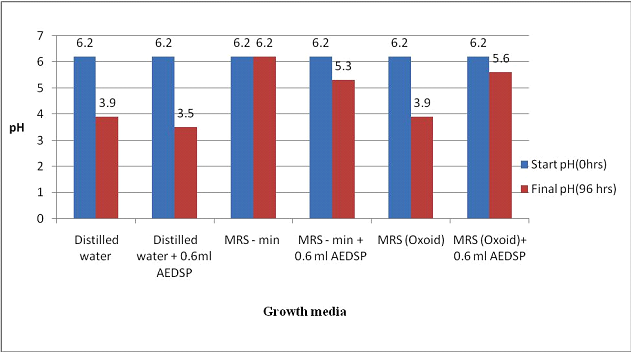
Figure 3.Changes in pH values of the same amount of aqueous extract of date seed powder (AEDSP): The starting (blue) and final pH (red) after (96 h) incubation for aqueous extract of date seed powder (AEDSP); Distilled water + 0.6ml AEDSP, MRS-Min + 0.6 ml AEDSP and MRS-Oxoid + 0.6 ml AEDSP.
The highest rate of growth was observed in MRS-Oxoid, then in the MRS-C + 0.6g FGDSP with less growth being observed in MRS-C +0.15g, then FGDSP MRS-C + 0.06g FGDSP. The most surprising observation in this fermentation assay was the decrease in the pH values from 6.2 to 3.9 in distilled water, the same as MRS-Oxoid, MRS-C + 0.6g FGDSP, MRS-C +0.15g and MRS-C + 0.06g FGDSP(Figures 1 and 2).
Table (4):
Enumeration (CFU /ml) of probiotic using aqueous extract of date seed powder(AEDSP).
Samples |
0h |
24h |
48h |
72h |
96h |
|---|---|---|---|---|---|
Distilled water |
5× 105 |
8× 106 |
8× 105 |
3× 105 |
1× 105 |
Distilled water + 0.6ml AEDSP |
3× 105 |
1× 106 |
1× 107 |
2× 107 |
2× 107 |
MRS-Min |
4× 105 |
2× 107 |
5× 107 |
2× 107 |
2× 107 |
MRS-Min + 0.6 ml AEDSP |
4× 105 |
2× 108 |
1× 108 |
1× 108 |
1× 108 |
MRS-Oxoid |
5× 105 |
3× 109 |
3× 107 |
6× 107 |
2× 107 |
MRS-Oxoid+ 0.6 ml AEDSP |
4× 105 |
2× 109 |
3× 107 |
4× 107 |
3× 107 |
Table (5):
Enumeration (CFU /ML) of probiotic using DFC, FGDSP and AEDSP..
Samples |
0h |
24h |
48h |
72h |
96h |
|---|---|---|---|---|---|
Distilled water |
2× 104 |
6× 106 |
7× 106 |
2× 106 |
1× 106 |
Distilled water + 0.6g DFC |
2× 104 |
6× 106 |
7× 106 |
8× 106 |
6× 106 |
Distilled water + 0.6g FGDSP |
2× 104 |
5× 107 |
9× 107 |
2× 108 |
1× 108 |
Distilled water + 0.6g AEDSP |
2× 104 |
5× 106 |
5× 106 |
1× 106 |
5× 105 |
In general, an increase in the numbers of probiotic was reported in response to the addition of the date seed product (FGDSP) during the fermentation period (96h), in addition to reducing the ph.
Enumeration of probiotics using aqueous extract of date seed powder (AEDSP) as carbon source (Second fermentation assay)
As shown in the table 4, the addition of 0.6 ml of AEDSP positively affects the total cell numbers of probiotic populations in the flasks of all the test media. The total cell number of probiotics was observed to increase after 24hr incubation in the MRS-Oxoid positive control with fewer numbers being observed in MRS-Oxoid + 0.6ml, and fewer again in MRS-Min containing 0.6 ml AEDSP and in the distilled water 0.6ml of AEDSP.
As observed in the first fermentation assay, the probiotic cell numbers in the FGDSP in the negative control (distilled water), increased during the first 24h, but after 48hrs incubation,
Generally, an increase in the total cell number of the probiotic was reported in response to the addition of AEDSP during the total fermentation period (96 h). The most significant observation in this assay was that there were no changes in the pH values in the flasks of the MRS-Min + 0.6 ml AEDSP compared to the MRS-Min control flask despite the fact that an increase in the total bacterial number was observed. In the other flasks the pH values decreased as the population number increased (Figure 7).
Comparing the probiotics growth rate and their ability to use the potential prebiotic in MRS-Min + 0.6 ml AEDSP and distilled water containing the same amount of the AEDSP, helped identify the optimum medium and this amount was used to grow the probiotic in the third fermentation assay. Given the results, distilled water supplemented with the date seed substrate was identified as a possible alternative medium to the MRS-Min supplemented with a date seed substrate, because it is a more economic option when translated to industrial scale.
Comparison of the ability of the probiotic Lactobacillus to utilize the three date seed substrates (dietary fibre concentrate, FGDSP and AEDSP)
The results shown in table 4 indicate that the DFC was utilized by the probiotic Lactobacillus. The total bacterial numbers in the negative control flask (distilled water) were compared with the other flask containing DFC during the fermentation period. The latter (DFC) may have supported the probiotic Lactobacillus growth especially after 48 h incubation (Figure 4). A pH decrease was observed with the test samples of the DFC, pH 3.8 (Figure 5). An increase in the total cell numbers of the probiotic was also observed in the flasks containing FGDSP and AEDSP, and a pH decrease was also observed.
Figure 4. Enumeration of probiotic using the date seed product; dietary fibre concentrate (DFC): the number of probiotic colony forming units (CFU/ml) after 0, 24, 48, 72, 96 h incubation to determine probioticability to utilise the dietary fibre concentrate (DFC) and distilled water.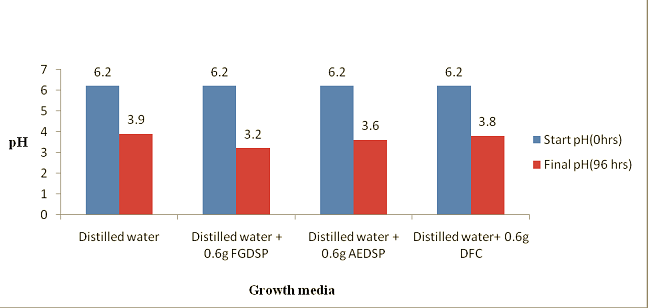
Figure 5. Changes in pH values during fermentation of the three date seed products: The starting (blue) and final(red) pH after (96hrs) incubation for the three date seed product; DFC, FGDSP and AEDSP
The highest probiotic Lactobacillus populations were observed in the flask containing the FGDSP with fewer numbers being observed in the DFC flask and a similar quantity observed in the AEDSP flask (Figure 6). In general, the probiotic Lactobacillus seems to utilize DFC as a carbon source, and an increase in the total number of probiotic populations were observed in response to the addition of each of the date seed products DFC, FGDSP and AEDSP over the course of the fermentation period (96 h).
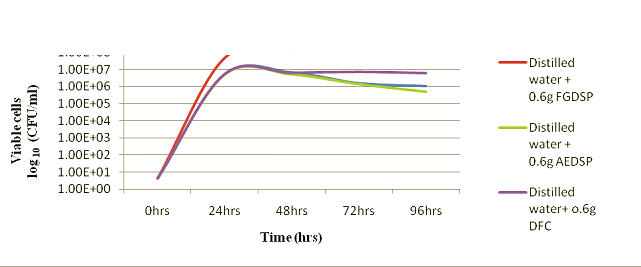
Figure 6.Comparison of the three date seeds products to be used as a substrate by probiotic lactobacilli; the number of probiotic colony forming: units (CFU/ML) after 0, 24,48,72,96 h; (DFC, FGDSP and AEDSP).
This is the first study that has used the three date seed products, finely ground date seed powder, (FGDSP); an aqueous extract of date seed powder (AEDSP) and dietary fibre concentrate (DFC) and studied their effects on the growth of the dairy probiotic Lactobacillus (L. paracasei ssp paracasei). The main reasons to divide the date seeds into three tested products in this study were: first, there was no available information so far about their biological effects on microbial growth, especially probiotics which was the main interest of this study. Secondly, to provide some data in relation to their potential use in functional foods that may serve as basic preliminary data in further studies.
This study has shown that date seeds could provide a suitable carbon source for probiotic fermentations and demonstrated their potential as a prebiotic. The viable count of the isolated LAB (probiotic) from Actimel yoghurt was 1.21×107 CFU/g. This value is within the range of the recommended value of total viable LAB in yoghurt which is between 1×106 to 5×108, depending on the characteristics of the yoghurt, such as its acidity (22). MRS-Oxoid is the recommended medium for isolation and enumeration of lactic acid bacteria (probiotics), because it contains glucose and peptone that provide carbon and nitrogen sources to support growth, as well as additional elements such as tween 80 (Polysorbate80) and other minerals like ammonium citrate and magnesium sulphate as growth factors which support the growth of LAB and inhibit the growth of other microorganisms (21). The commercially available medium was used to recover the probiotic cultures and to enumerate them during this study. The medium was also prepared in the laboratory in its modified form which did not contain a carbon source so that it could be supplemented with the date seed products e.g. FGDSP in the first fermentation assay, to study that potential of date kernels as a carbon source for prebiotic fermentation.
An increase in the number of the probiotic population in the flask that contained date seed powder was observed in the first fermentation assay. This may result from adding the FGDSP to the fermentation. Generally, date seeds contain high amounts of total carbohydrates, 83.1% as reported by (15). Thus, the probiotic Lactobacillus may have utilized the date powder (FGDSP) as an additional carbon source to support its growth and to increase the total numbers of bacteria in the population. One of the observations in this study indicates that growth of the probiotic was supported for 24 to 48 hr of incubation in the distilled water in a negative control in the fermentation assays. This may have resulted from carryover of residual nutrients from the inoculum, which were available to use by microorganisms. Thus, the number of bacteria in the negative control slightly increased during the first day of the fermentation, but thereafter, the total number of bacterial population dramatically decreased because there were not sufficient nutrients to support the microbial growth and cell death, perhaps from osmotic lysis, in that negative control flask happened later.
In the second fermentation assay, the aqueous extract of date seed powder (AEDSP) was investigated for its effect on the growth of the probiotic cultures. The total microbial populations were less than those reported with the FGDSP used in the first fermentation assay. But if we compare the AEDSP fermentations with the control fermentions in that assay, generally, the total bacterial numbers in the fermenter vessels with the date product were more than with the control. This may be due to the fact that the probiotics used the date seeds extract as a carbon source.
The last fermentation assay was carried out to confirm the results from the first and second fermentation assays and to study the ability of the probiotic Lactobacillus to control the growth foodborne pathogens and to investigate the prebiotic properties of date palm DFC in stimulating probiotic Lactobacillus bacteriocin production was also investigated.
An increase in the total numbers of viable bacteria in the FGDSP and AEDSP fermentations (Figure 9) confirmed that these two date seed products could provide a suitable carbon source to support microbial growth. The investigations that were carried out in the extracted dietary fiber concentrates (DFC) demonstrated that the total numbers of probiotic bacteria were increased in the first 72 h of incubation whereas the total bacterial populations decreased after 48 h incubation as shown in. Thus, as DFC was utilized by the probiotic cultures, it may act as a prebiotic. The pH values were decreased from 6.2 at the start of fermentation to a pH between 3.2 and 3.9 in all the fermentation assays, which indicated that date seed did not stop one of the main important features for the probiotic to be functional, which is to produce acids. The results of the antimicrobial activities of the three date seed products that were investigated in this study indicated that no significant zones of inhibition were observed around the three test discs in the agar diffusion assay compared with the positive control which measured (5 mm) and the negative control. One of the scientific criteria for functional food ingredients to be recognized and classified as a prebiotic is that it inhibits the growth of pathogenic bacteria (23). Hence, in general, reducing the pH values in this study was evidence to indicate that DFC from date seeds may be used as prebiotic. However, this result should be taken into account in further studies.
Most studies performed on date seeds have investigated only their chemical composition. Recent studies have reported the potential use of date kernels in functional foods, especially those containing a large amount of carbohydrates and specifically dietary fibre. However, the present study to the best of my knowledge, this is the first time that microbiological studies on date kernels have been presented. This study has shown that the two date palm substrates FGDSP and AEDSP can potentially be utilized as carbon sources suitable for bacterial fermentation. The DFC exhibited the potential to be used as a novel source of prebiotic by increasing the population of probiotic Lactobacillus paracasei ssp paracasei with a concomitant decrease in the pH values of the medium.
This study proposes that date kernels could potentially be a cheap source of prebiotics and could easily be utilized as a functional food ingredient, converting a waste product into an economically viable food substrate. However, further investigations need to be carried out by in suitable animal model to corroborate the potential prebiotic effect of the date palm (Phoenix dactylifera L.) seed product dietary fibre concentrate (DFC).
- Gibson, G. R., Roberfroid, M. B. Dietary modulation of the human colonic microbiota: introducing the concept of prebiotics. 1995; 125, 1401.
- Gibson, G. R., Probert, H. M., Loo, J. V., Rastall, R. A., Roberfroid, M. B. Dietary modulation of the human colonic microbiota: updating the concept of prebiotics. Nutr. Res. Rev., 2004; 17: 259-75.
- Wang, Y. Prebiotics: Present and future in food science and technology. Food Res. Int., 2009; 42: 8-12.
- Mandalari, G., Nueno-Palop, C., Bisignano, G., Wicham, M. S. J., Narbad, A. Potential prebiotic properties of almond (Amygdalus communis L.) seeds? Appl. Environ. Microbiol., 2008; 74: 4264-70.
- Mandalari, G., Nueno Palop, C., Tuohy, K., Gibson, G. R., Bennett, R. N., Waldron, K. W., Bisignano, G., Narbad, A., Faulds, C. B. In vitro evaluation of the prebiotic activity of a pectic oligosaccharide-rich extract enzymatically derived from bergamot peel. Appl. Microbiol. Biotechnol., 2007; 73: 1173-9.
- Menne, E., Guggenbuhl, N. Fn-type chicory inulin hydrolysate has a prebiotic effect in humans. J. Nutr., 2000; 130: 1197-1199.
- Rao, V. A. The prebiotic properties of oligofructose at low intake levels. Nutr. Res., 2001; 21: 843-8.
- Tuohy, K. M., Ziemer, C. J., Klinder, A., Knobel, Y., Pool-Zobel, B. L., Gibson, G. R. A human volunteer study to determine the prebiotic effects of lactulose powder on human colonic microbiota. Microb. Ecol. Health Dis., 2002; 14: 165-173.
- Amer, W. M. Taxonomic and documentary study of food plants in Ancient Egypt. Ph.D. Thesis, 1994; Cairo University.
- Mcclintock, E. Arecaceae palm family. The Jepson Manual: 1993; http://ucjeps.berkeley.edu/cgi-bin/get_JM_treatment.pl?Phoenix+dactylifera.
- Hussein, A. S., Al-Haami, G. A., Khalil, Y. H. The use of dates and date pits in broiler starter and finisher diets. Biores. Technol., 1998; 66: 219-24.
- Al-Farsi, M. A., Lee, C. Y. Optimization of phenolics and dietary fibre extraction from date seeds. Food Chem., 2008; 108: 977-85.
- Al-Farsi, M., Alasalvar, C., Al-Abid, M., Al-Shoail, K., Al-Amry, M., Al-Rawahy, F. Compositional and functional characteristics of dates, syrups, and their by-products. Food Chem.try, 2007; 104: 943-7.
- Al-Dhaheri, A., Al-Hadrami, G., Aboalnaga, N., Wasfi, I., Elridi, M. Chemical composition of date pits and reproductive hormonal status of rats fed date pits. Food Chem., 2004; 86: 93-7.
- Besbes, S., Blecker, C., Deroanne, C., Drira, N. E., Attia, H. Date seeds: chemical composition and characteristic profiles of the lipid fraction. Food Chem., 2004; 84: 577-84.
- Hamada, J. S., Hashim, I. B., Sharif, F. A., Usda, A. R. S. Preliminary analysis and potential uses of date pits in foods. Food Chem., 2002; 76: 135-37.
- Al-Hooti, S., Sidhu, S. S., Gabazard, H. Chemical composition of seeds of date fruit cultivars of United Arab Emirates. J. Food Scie. Technol., 1998; 35: 44-46.
- Attalia, A. M., Harraz, F. M. Chemical Composition of the pits of selected date palm cultivars grown in the Qassim region, Saudi Arabia. Arab Gulf J. Scie. Res., 1996; 14: 629-40.
- Almana, H. A., Mahmoud, R. M. Palm date seeds as an alternative source of dietary fiber in Saudi bread. Ecol. Food Nutri., 1994; 32(3/4): 261-70.
- Badis, A., Guetarni, D., Moussa-Boudjemaa, B., Henni, D. E., Tornadijo, M. E., Kihal, M. Identification of cultivable lactic acid bacteria isolated from Algerian raw goat’s milk and evaluation of their technological properties. Food Microbiol., 2004; 21: 343-49.
- Rybka, S., Kailasapathy, K. Media for the enumeration of yoghurt bacteria. Int. Dairy J., 1996; 6: 839-50.
- Birollo, G. A., Reinheimer, J. A., Vinderola, C. G. Viability of lactic acid microflora in different types of yoghurt. Food Res. Int., 2000; 33: 799-805.
- Gibson, G.R., Probert, H.M., Loo, J.V., Rastall, R.A., Roberfroid, M.B. Dietary modulation of the human colonic microbiota: updating the concept of prebiotics. Nutr. Res. Rev., 2004; 17(2): 259-75.
© The Author(s) 2017. Open Access. This article is distributed under the terms of the Creative Commons Attribution 4.0 International License which permits unrestricted use, sharing, distribution, and reproduction in any medium, provided you give appropriate credit to the original author(s) and the source, provide a link to the Creative Commons license, and indicate if changes were made.


